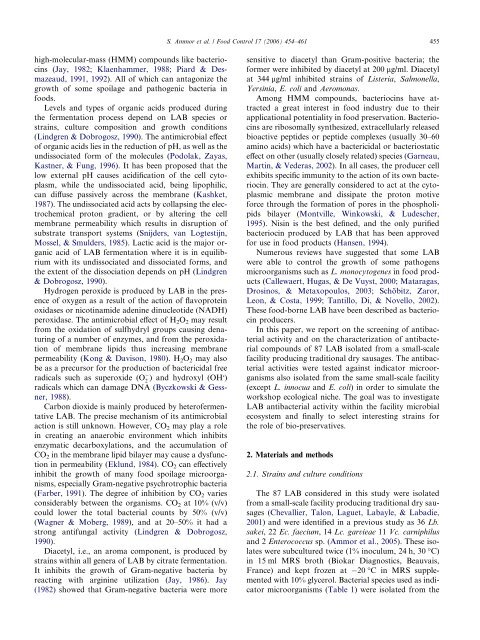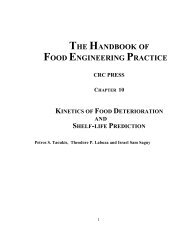Antibacterial activity of lactic acid bacteria against spoilage and ...
Antibacterial activity of lactic acid bacteria against spoilage and ...
Antibacterial activity of lactic acid bacteria against spoilage and ...
Create successful ePaper yourself
Turn your PDF publications into a flip-book with our unique Google optimized e-Paper software.
high-molecular-mass (HMM) compounds like bacteriocins<br />
(Jay, 1982; Klaenhammer, 1988; Piard & Desmazeaud,<br />
1991, 1992). All <strong>of</strong> which can antagonize the<br />
growth <strong>of</strong> some <strong>spoilage</strong> <strong>and</strong> pathogenic <strong>bacteria</strong> in<br />
foods.<br />
Levels <strong>and</strong> types <strong>of</strong> organic <strong>acid</strong>s produced during<br />
the fermentation process depend on LAB species or<br />
strains, culture composition <strong>and</strong> growth conditions<br />
(Lindgren & Dobrogosz, 1990). The antimicrobial effect<br />
<strong>of</strong> organic <strong>acid</strong>s lies in the reduction <strong>of</strong> pH, as well as the<br />
undissociated form <strong>of</strong> the molecules (Podolak, Zayas,<br />
Kastner, & Fung, 1996). It has been proposed that the<br />
low external pH causes <strong>acid</strong>ification <strong>of</strong> the cell cytoplasm,<br />
while the undissociated <strong>acid</strong>, being lipophilic,<br />
can diffuse passively across the membrane (Kashket,<br />
1987). The undissociated <strong>acid</strong> acts by collapsing the electrochemical<br />
proton gradient, or by altering the cell<br />
membrane permeability which results in disruption <strong>of</strong><br />
substrate transport systems (Snijders, van Logtestijn,<br />
Mossel, & Smulders, 1985). Lactic <strong>acid</strong> is the major organic<br />
<strong>acid</strong> <strong>of</strong> LAB fermentation where it is in equilibrium<br />
with its undissociated <strong>and</strong> dissociated forms, <strong>and</strong><br />
the extent <strong>of</strong> the dissociation depends on pH (Lindgren<br />
& Dobrogosz, 1990).<br />
Hydrogen peroxide is produced by LAB in the presence<br />
<strong>of</strong> oxygen as a result <strong>of</strong> the action <strong>of</strong> flavoprotein<br />
oxidases or nicotinamide adenine dinucleotide (NADH)<br />
peroxidase. The antimicrobial effect <strong>of</strong> H2O2 may result<br />
from the oxidation <strong>of</strong> sulfhydryl groups causing denaturing<br />
<strong>of</strong> a number <strong>of</strong> enzymes, <strong>and</strong> from the peroxidation<br />
<strong>of</strong> membrane lipids thus increasing membrane<br />
permeability (Kong & Davison, 1980). H 2O 2 may also<br />
be as a precursor for the production <strong>of</strong> bactericidal free<br />
radicals such as superoxide (O 2 ) <strong>and</strong> hydroxyl (OH )<br />
radicals which can damage DNA (Byczkowski & Gessner,<br />
1988).<br />
Carbon dioxide is mainly produced by heter<strong>of</strong>ermentative<br />
LAB. The precise mechanism <strong>of</strong> its antimicrobial<br />
action is still unknown. However, CO 2 may play a role<br />
in creating an anaerobic environment which inhibits<br />
enzymatic decarboxylations, <strong>and</strong> the accumulation <strong>of</strong><br />
CO2 in the membrane lipid bilayer may cause a dysfunction<br />
in permeability (Eklund, 1984). CO2 can effectively<br />
inhibit the growth <strong>of</strong> many food <strong>spoilage</strong> microorganisms,<br />
especially Gram-negative psychrotrophic <strong>bacteria</strong><br />
(Farber, 1991). The degree <strong>of</strong> inhibition by CO2 varies<br />
considerably between the organisms. CO 2 at 10% (v/v)<br />
could lower the total <strong>bacteria</strong>l counts by 50% (v/v)<br />
(Wagner & Moberg, 1989), <strong>and</strong> at 20–50% it had a<br />
strong antifungal <strong>activity</strong> (Lindgren & Dobrogosz,<br />
1990).<br />
Diacetyl, i.e., an aroma component, is produced by<br />
strains within all genera <strong>of</strong> LAB by citrate fermentation.<br />
It inhibits the growth <strong>of</strong> Gram-negative <strong>bacteria</strong> by<br />
reacting with arginine utilization (Jay, 1986). Jay<br />
(1982) showed that Gram-negative <strong>bacteria</strong> were more<br />
S. Ammor et al. / Food Control 17 (2006) 454–461 455<br />
sensitive to diacetyl than Gram-positive <strong>bacteria</strong>; the<br />
former were inhibited by diacetyl at 200 lg/ml. Diacetyl<br />
at 344 lg/ml inhibited strains <strong>of</strong> Listeria, Salmonella,<br />
Yersinia, E. coli <strong>and</strong> Aeromonas.<br />
Among HMM compounds, bacteriocins have attracted<br />
a great interest in food industry due to their<br />
applicational potentiality in food preservation. Bacteriocins<br />
are ribosomally synthesized, extracellularly released<br />
bioactive peptides or peptide complexes (usually 30–60<br />
amino <strong>acid</strong>s) which have a bactericidal or bacteriostatic<br />
effect on other (usually closely related) species (Garneau,<br />
Martin, & Vederas, 2002). In all cases, the producer cell<br />
exhibits specific immunity to the action <strong>of</strong> its own bacteriocin.<br />
They are generally considered to act at the cytoplasmic<br />
membrane <strong>and</strong> dissipate the proton motive<br />
force through the formation <strong>of</strong> pores in the phospholipids<br />
bilayer (Montville, Winkowski, & Ludescher,<br />
1995). Nisin is the best defined, <strong>and</strong> the only purified<br />
bacteriocin produced by LAB that has been approved<br />
for use in food products (Hansen, 1994).<br />
Numerous reviews have suggested that some LAB<br />
were able to control the growth <strong>of</strong> some pathogens<br />
microorganisms such as L. monocytogenes in food products<br />
(Callewaert, Hugas, & De Vuyst, 2000; Mataragas,<br />
Drosinos, & Metaxopoulos, 2003; Schöbitz, Zaror,<br />
Leon, & Costa, 1999; Tantillo, Di, & Novello, 2002).<br />
These food-borne LAB have been described as bacteriocin<br />
producers.<br />
In this paper, we report on the screening <strong>of</strong> anti<strong>bacteria</strong>l<br />
<strong>activity</strong> <strong>and</strong> on the characterization <strong>of</strong> anti<strong>bacteria</strong>l<br />
compounds <strong>of</strong> 87 LAB isolated from a small-scale<br />
facility producing traditional dry sausages. The anti<strong>bacteria</strong>l<br />
activities were tested <strong>against</strong> indicator microorganisms<br />
also isolated from the same small-scale facility<br />
(except L. innocua <strong>and</strong> E. coli) in order to simulate the<br />
workshop ecological niche. The goal was to investigate<br />
LAB anti<strong>bacteria</strong>l <strong>activity</strong> within the facility microbial<br />
ecosystem <strong>and</strong> finally to select interesting strains for<br />
the role <strong>of</strong> bio-preservatives.<br />
2. Materials <strong>and</strong> methods<br />
2.1. Strains <strong>and</strong> culture conditions<br />
The 87 LAB considered in this study were isolated<br />
from a small-scale facility producing traditional dry sausages<br />
(Chevallier, Talon, Laguet, Labayle, & Labadie,<br />
2001) <strong>and</strong> were identified in a previous study as 36 Lb.<br />
sakei, 22Ec. faecium, 14Lc. garvieae 11 Vc. carniphilus<br />
<strong>and</strong> 2 Enterococcus sp. (Ammor et al., 2005). These isolates<br />
were subcultured twice (1% inoculum, 24 h, 30 °C)<br />
in 15 ml MRS broth (Biokar Diagnostics, Beauvais,<br />
France) <strong>and</strong> kept frozen at 20 °C in MRS supplemented<br />
with 10% glycerol. Bacterial species used as indicator<br />
microorganisms (Table 1) were isolated from the














